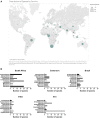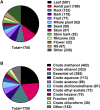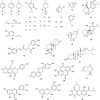A Systematic Review of Plants With Antibacterial Activities: A Taxonomic and Phylogenetic Perspective
- PMID: 33488385
- PMCID: PMC7821031
- DOI: 10.3389/fphar.2020.586548
A Systematic Review of Plants With Antibacterial Activities: A Taxonomic and Phylogenetic Perspective
Abstract
Background: Antimicrobial resistance represents a serious threat to human health across the globe. The cost of bringing a new antibiotic from discovery to market is high and return on investment is low. Furthermore, the development of new antibiotics has slowed dramatically since the 1950s' golden age of discovery. Plants produce a variety of bioactive secondary metabolites that could be used to fuel the future discovery pipeline. While many studies have focused on specific aspects of plants and plant natural products with antibacterial properties, a comprehensive review of the antibacterial potential of plants has never before been attempted. Objectives: This systematic review aims to evaluate reports on plants with significant antibacterial activities. Methods: Following the PRISMA model, we searched three electronic databases: Web of Science, PubMed and SciFinder by using specific keywords: "plant," "antibacterial," "inhibitory concentration." Results: We identified a total of 6,083 articles published between 1946 and 2019 and then reviewed 66% of these (4,024) focusing on articles published between 2012 and 2019. A rigorous selection process was implemented using clear inclusion and exclusion criteria, yielding data on 958 plant species derived from 483 scientific articles. Antibacterial activity is found in 51 of 79 vascular plant orders throughout the phylogenetic tree. Most are reported within eudicots, with the bulk of species being asterids. Antibacterial activity is not prominent in monocotyledons. Phylogenetic distribution strongly supports the concept of chemical evolution across plant clades, especially in more derived eudicot families. The Lamiaceae, Fabaceae and Asteraceae were the most represented plant families, while Cinnamomum verum, Rosmarinus vulgaris and Thymus vulgaris were the most studied species. South Africa was the most represented site of plant collection. Crude extraction in methanol was the most represented type of extraction and leaves were the main plant tissue investigated. Finally, Staphylococcus aureus was the most targeted pathogenic bacteria in these studies. We closely examine 70 prominent medicinal plant species from the 15 families most studied in the literature. Conclusion: This review depicts the current state of knowledge regarding antibacterials from plants and provides powerful recommendations for future research directions.
Keywords: antibacterial; antimicrobial; ethnopharmacology; medicinal plants; minimum inhibitory concentration.
Copyright © 2021 Chassagne, Samarakoon, Porras, Lyles, Dettweiler, Marquez, Salam, Shabih, Farrokhi and Quave.
Conflict of interest statement
The authors declare that the research was conducted in the absence of any commercial or financial relationships that could be construed as a potential conflict of interest.
Figures















References
-
- Abad M. J., Bermejo P., Villar A. (1995). An approach to the genus Tanacetum L. (Compositae): phytochemical and pharmacological review. Phytother Res. 9, 79–92. 10.1002/ptr.2650090202 - DOI
-
- Aboelsoud N. H. (2010). Herbal medicine in ancient Egypt. J. Med. Plants Res. 4, 082–086. 10.5897/JMPR09.013 - DOI
-
- Abolfazl M., Hadi A., Frhad M., Hossein N. (2014). In vitro antibacterial activity and phytochemical analysis of some medicinal plants. J. Med. Plants Res. 8, 186–194. 10.5897/jmpr12.1298 - DOI
Publication types
Grants and funding
LinkOut - more resources
Full Text Sources
Other Literature Sources

